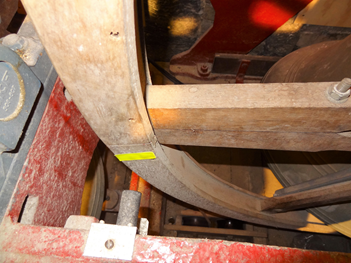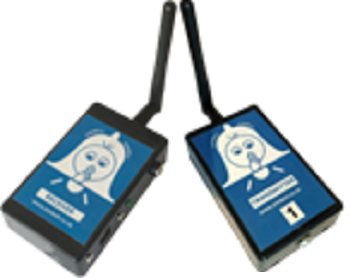Simulator Toolbox
2. Installing a simulator
2.4. Sensors
There are a number of different sensor systems on the market and there is also the option to make your own. Each sensor system has advantages and disadvantages. The number of sensors and how you intend to use the system all need to be considered carefully before choosing a system:
- Unless you are confident about electronics, you would be best advised to purchase a tried and tested off-the-shelf system.
- Hard-wired or wireless? Hard-wired systems are the most common, although cable management is an issue. The newer wireless sensors avoid the problems of cables running around the bell frame and are easily transported. The same set of sensors can be used in more than one tower.
- If you are using the installation for teaching, you may only need sensors on one or two bells. However, the systems also double up as an alternative to installing sound control and you may want all of the bells connected.
Optical sensors
For over 20 years David Bagley has been making optical sensor systems. The sensors themselves can be fitted to the frame either with screws or by wrapping plastic insulation tape around them and the frame. Similarly, plastic insulation tape can be used to clip the cables out of the way. How do they work? Light generated by a LED strikes a reflective strip on the wheel and the sensor sends a signal to the computer. The reflective strip is placed opposite the sensor when the bell is down. A delay needs to be incorporated before making the sound of a bell which is set using the computer. The delay varies from bell to bell in a ring by weight. Typically for a ring with a 12cwt tenor the delay varies from about 350ms to 450ms. The accuracy of the human ear is limited to around ± 30ms and bells can also be odd-struck. Therefore, it can be difficult to set up the sensor precisely. However, adjusting the delay so that the sounds coincide with those of the real bell is not difficult and will be near enough for most practical purposes. The Bagley system comes with 9-pin serial connections to the computer. These days many laptops and small computers do not have 9-pin serial ports and it is usually necessary to purchase an additional USB-Serial converter. |
Magnetic sensors
John Thorpe makes a solid state magnetic system and the basic layout of the system is similar to the optical system. The interface with the computer is via a USB so there is no need for a converter. The sensors are made in a completely sealed unit and this, along with the use of waterproof connectors, ensures that they are dust and moisture-proof and therefore offer reliable operation in the less-than-ideal environment of many bell chambers. |
Radio Frequency (RF) Sensors
Simbell is based on standard Radio Frequency (RF) technology and offers similar advantages to wireless sensors. This system has a good range and almost zero latency (a few micro-seconds). It is quite possible to power 6 or 8 transmitters for several hours on a single rechargeable battery pack. Originally designed to simulate sound only for silent practice in towers without sound control, the sensors are compatible with Abel, Beltower and Virtual Belfry. There are some helpful videos on the Simbell YouTube channel. |
Making your own sensors
Sensors and the interface are two entirely different things. Most people understand the sensors well enough; the challenge is getting the signal into the computer. But it can, in fact, be very easy.
The minimum circuit for a single bell requires a USB-serial converter, a reed switch and a magnet. It is also easy to make your own multi-bell interface using some fairly basic programming. A suitable converter can be bought for about £10 and it allows you to connect up to 4 bells. The help pages in each application explain more, although the electronics and the programming, while quite basic for some, may be too daunting for others.
Multi-bell installations
A multi-bell installation allows you to use the system as an alternative form of sound control and to practise on any bell. The sensors are quite sensitive and, if you are practising with the other bells down, any slight motion can set them off. There are options within the software to switch the other bells off, or you can simply ring any offending bells up.